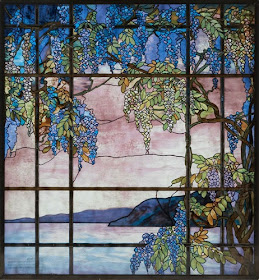Window from the ballroom of the Tiffany family home in New York, 1885-1992.
In 1892 Tiffany opened a glass house in the Corona neighborhood of Queens, working with English glass-blower Arthur Nash. They developed a form of blended, opalescent glass they called Favrile, and they used this in conjunction with traditional clear pieces to create a great variety of colors and looks. You can clearly see the opalescent, semi-transparent glass in this famous work, Magnolias and Irises, 1908.
Within a decade their studio was world famous and a huge financial success. Most of the money came from the mass production of vases and lamps, but Tiffany himself continued to put much of his own effort into windows. (Parakeets, 1889, and detail)
A religious man but not much of a sectarian, Tiffany created many windows for churches, synagogues, Universalist meeting halls, and other places of worship. This array of windows is at St. Michael's Episcopal Church on Amsterdam Avenue in Manhattan.
The Angel of the Resurrection, from the First Presbyterian Church, Indianapolis, 1905
Dogwood, 1915.
Hudson River Landscape from Rochroane, 1905
Panels from the Presbyterian Church, Norfolk, Connecticut.
Snowball panel, 1904.
Field of Lillies from the Tiffany Chapel, Laurelton Hall, New York c. 1892-1900.













It's nice to see that if one discounts all the terrible, tacky, mass-produced and overused junk that his name is most instantly evocative of, Tiffany actually made some pretty nice pieces.
ReplyDelete